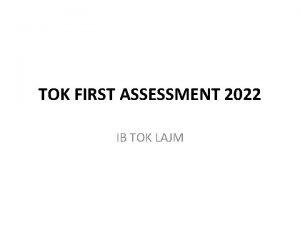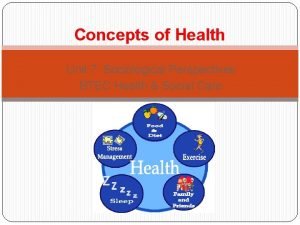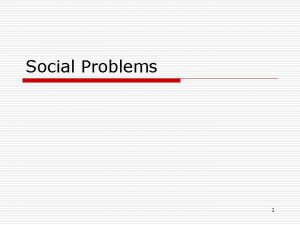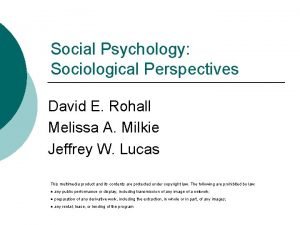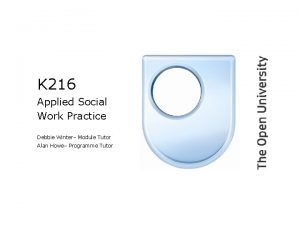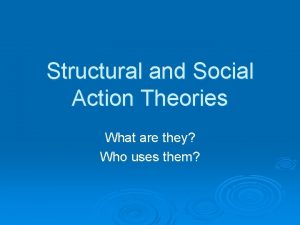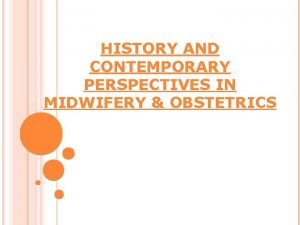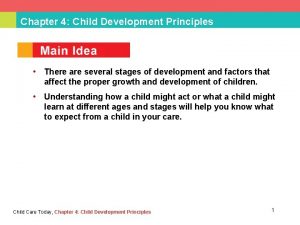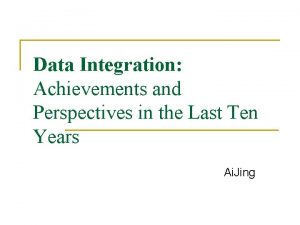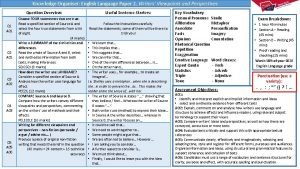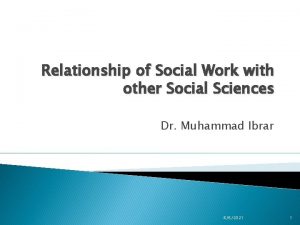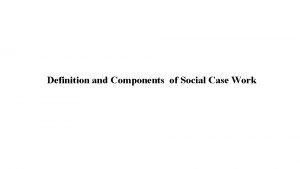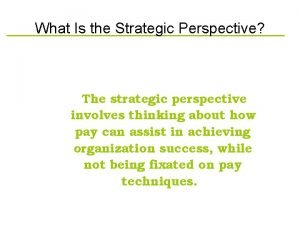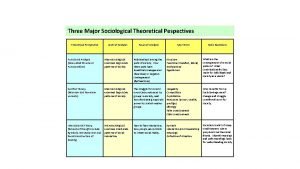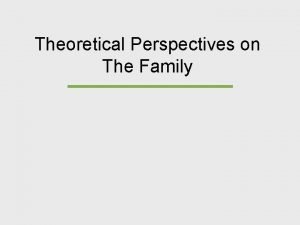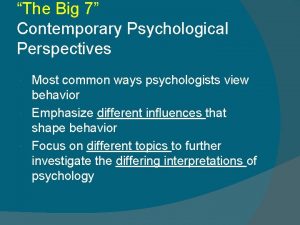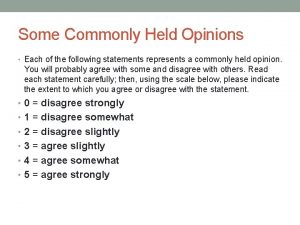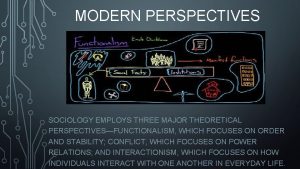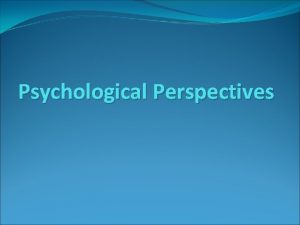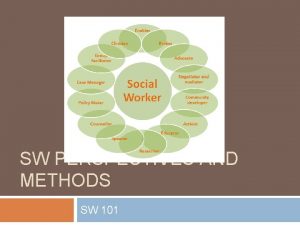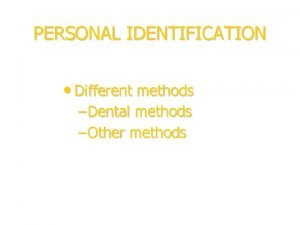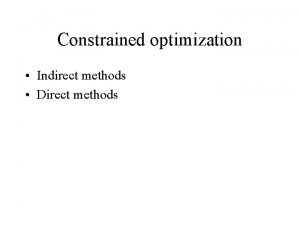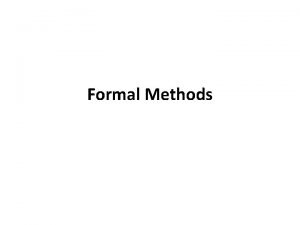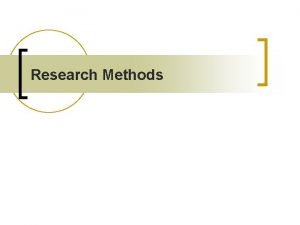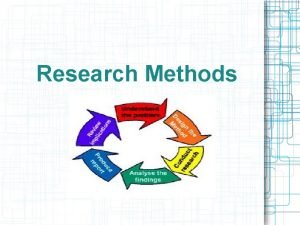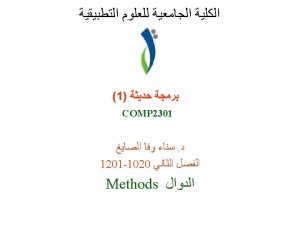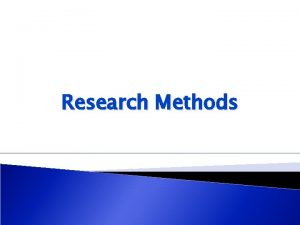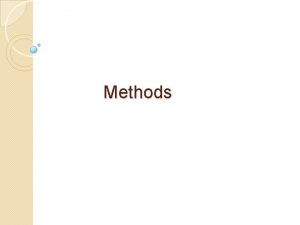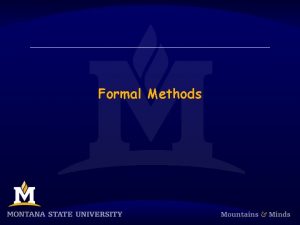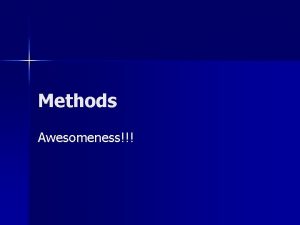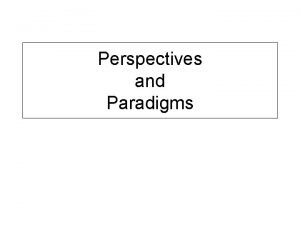Social Work Perspectives and Methods FROM SOCIAL WORK





































- Slides: 37

Social Work Perspectives and Methods FROM SOCIAL WORK AND SOCIAL WELFARE BY MARLA BERG-WEGER


Chapter 7: Fundamentals 1. What generalist practice means 2. The diversity of roles of such a practice 3. The theory behind our practice 4. An assessment tool that is an example of our theory 5. Practice models that are common to social workers 6. In other words, all you ever wanted to know about social work but were to afraid to ask…right?

Generalist Social Work ●Statement of generalist practice: p 305 -306 ●Generalist social work practice involves a broadbased set of knowledge and skills for assessing and intervening at multiple levels ●Social workers on a generalist level “strengthen relationships among people in a purposeful effort to promote, restore, maintain, and enhance the well-being of individuals, families, social groups, organizations, and communities. ”

Levels of Generalist Practice ●Individuals and families ●Working one-on-one with those facing problems and transitions ●Groups ●Facilitating support, task, information, skill-building, and other types of groups ●Organizations ●Community organizing, policy analysis, administration, and more

What does Generalist practice mean? 1. 2. 3. 4. Systems’ theory Eclectic knowledge base Core competency areas (curriculum areas) Empowerment, evidence-based practice, critical thinking skills 5. Reliance on professional values, ethics, wide range of skills, multiple target systems 6. Work in organizational structure, supervision 7. Professional roles, planned changed process

Major Concepts in Generalist SW

Pictorial view of Generalist Practice: SW text

Integration of theory into practice chart (p 314) 1. We begin with critical thinking and reflection; relationship is at the heart of what we do (every class is about critical thinking and selfreflection, and skills in being an effective interviewer) 2. The theoretical component: our practice theory, our common roles and responsibilities (theory undergirds our practice, meaning? ) 1. 2. 3. 4. Rationality>cognitive intervention The power of language>solution focused intervention Ecosystems’>person in environment Strengths-based>not deficit-focused, problem-focused, believing we all possess strengths, resources, potential for change 3. Also, shaping our thinking is legal system, policy, and the people/organization that we serve 4. Leading to practice knowledge ◦ Ethics ◦ Practice strategies ◦ Interviewing skills

Theory and Practice ●Theory in social work encompasses both empirical research and pragmatism—explanations that emanate from practice ●Researchers test practice theory so that social workers have evidence that a particular approach is appropriate. The result is evidence-based practice.

Social work: Ecosystems model Environmental Culture Family Individual

Interventions applications Micro practice (individuals) Micro/mezzo practice (families) Mezzo practice (groups) Macro practice (organizations & communities) 6/11/2021

Uniqueness of Social Work 1. Complexity of problems (avoiding black/white thinking) 2. Systemic solutions-person in environment is target for change 3. Advocacy for clients (maybe person or groups) 4. Code of Ethics 5. Client self-determination 6. Strengths-perspective 6/11/2021

Someone who: Who has a letter in their first name that is in your first name: exa: I go by jim, so I am looking for someone with a j or i or m in their first name.

Let’s apply a strengths-based approach to you: I like myself because_________________ I do ____________________very well I feel good about __________________ My friends would tell you I have a great _________ People say I am a good________________

Feedback: a systems/communications concept What difference does it make to focus on strengths? How did it impact you to focus on your strengths? Any difference in how you feel now than when you walked in this morning? Change begins with our presence and with our focus: who we are and what we choose to focus on.


Generalist social work skills and roles ●A generalist social worker can serve as a:

Broker ●Helps link client systems to needed resources. Could include: A school board meeting in Monroe, OH. Image by Jon Beagle, used under Creative Commons license. ● Helping an older adult apply for assistance with his heating bill ● Assisting a group of parents of children with ADD to meet with the school board to improve school-based services ● Working with another social service agency to streamline their application process for their clients ● Securing resources be it internally or externally, within the setting or outside the setting

Advocate ●Helps to voice the needs of a client or group to facilitate a change ●Often, social workers will strive to impact a positive change in an unjust situation. For example, the social worker can advocate on behalf of a client at the adoption hearing, or she or he can lobby the state legislature to enact laws to address the needs of foster children. A town hall meeting. Image by Bart Everson, used under Creative Commons license. ●Attend meetings to advocate for improved medical care, police protection, working to mainstream a student in school, etc.

Direct Service Provider ●Includes counseling and therapy ●Assessing needs and developing plans for intervening toward goals, either on the individual/family level or at the organizational/community level. ●At this level, a social worker might: Image by Corrine Brown, used under Creative Commons license. ● Meet with people seeking counseling or conduct intake surveys for an organization (work with individuals and families) ● Facilitate a group for people experiencing a life change (group facilitator) ● Collaborate with individuals to develop a plan for improving their neighborhood safety (community planner)

Case Manager ●Serves as a liaison between the client and the systems needed to meet the goals of the intervention ●Case managers provide referrals to resources in areas such as housing, mental health, financial, employment, and transportation ●Assess for need and then develop plans for getting the needs met A Warrior Transition Battalion nurse case manager. Image by Gloria Montgomery, used under Creative Commons license.

Educator ●Provides information to the client ●In one-on-one encounters with clients, the social worker conveys information on strategies for coping, enhancing well-being, using resources, and identifying alternative behaviors. ●Social workers also engage in making presentations, facilitating groups, and lobbying A USACE healthy living group. Photo by USACE Europe District, used under Creative Common license. ●Such as stress management, trauma debriefings, parenting, relationship, first offender, bereavement

Organizer ●Social workers can use organizing skills at all levels ●Having knowledge of the operations of organizations, social workers can mobilize resources to fulfill the client’s needs and goals ●As generalist practitioners, social workers can analyze the strengths and deficiencies of policies and programs and work toward influencing change within those systems. An NALC food drive. Photo by Bernard Pollack, used under Creative Commons license. ●More administrative and management, as well as supervision

Supervisor and Manager Supervisor: motivate, coordinate workload, corrective feedback, set goals, monitor & improve work processes, educate & consult with employees, target system more micro Manager: program development & evaluation, oversight of agency basic activities, conflict management, more administrative responsibilities, target system more macro

Planned change process (problem solving) Engagement: initial contact, warmth, empathy, genuineness Assessment: needs & strengths, sensitivity to diversity issues, consideration all systems, traditional & strengths-based Planning: specifying course of action, what is the plan of action, how are goals to be achieved Implementation: carrying out of the plan

Planned change process (cont) Evaluation: “process of determining whether or not a given change effort [or intervention] was worthwhile. ” Termination: “the end of the professional social worker -client [be it micro/mezzo/macro] relationship. ”

Assessments: heart & soul of social work practice Gathering information, a multisystems assessments, the critical events time line

Ecosystems perspective: assessment Community Culture Family Individual

And a tool that reflects our ecosystems’ perspective: _____ You _____

Your ecomap? Add +/- for strength of the relationship (at least 5 -6 on map) _____ You _____

My ecomap wife parents colleagues Me children Friends sibling

Your ecomap? Add +/- for strength of the relationship (at least 5 -6 on map) _____ You _____

Interviewing as a social worker Remember that interviewing is a combination of setting someone at ease and gathering information. When the client feels safe, even comfortable, you are more likely able to get important information. Information that will lead to your change strategy/ies. With this in mind, ask the ‘client’ about what they learned about their social network using the ecomap? What did you learn about yourself? Were there any surprises? Is there any of these relationships that need your attention? You pick the question/s.

Social Work Practice 101: partner up (same letter in first name)… Behaviors Undivided attention—not distracted Client’s speech is uninterrupted Eye behavior—eye contact, staring, eye movement Facial expressions—congruent with client’s affect Open-ended question: you have some questions that I have provided for you. (share ONLY what you are comfortable sharing with this partner)


Social Work Practice 101: Try this out… Behaviors Undivided attention—not distracted Client’s speech is uninterrupted Eye behavior—eye contact, staring, eye movement Facial expressions—congruent with client’s affect Open-ended questions—whuzzup? Maybe not! What have been some significant events in your past? Might be a better start. Give it a try!
 Tok exhibition examples
Tok exhibition examples Unit 7 health and social care
Unit 7 health and social care The social and ethical perspectives of entrepreneurship
The social and ethical perspectives of entrepreneurship Definition of a social issue
Definition of a social issue Social psychology sociological perspectives
Social psychology sociological perspectives Methods in social work
Methods in social work Indirect wax pattern
Indirect wax pattern Structural functionalism examples
Structural functionalism examples Professional nursing practice: concepts and perspectives
Professional nursing practice: concepts and perspectives Historical and contemporary perspectives in midwifery ppt
Historical and contemporary perspectives in midwifery ppt What are the 4 principles of child development
What are the 4 principles of child development Perspective anthropology
Perspective anthropology Perspective and methodology of economics
Perspective and methodology of economics Data integration problems approaches and perspectives
Data integration problems approaches and perspectives Personological and life story perspectives
Personological and life story perspectives Gregor andrade
Gregor andrade Define family matters
Define family matters Writers viewpoints and perspectives
Writers viewpoints and perspectives Political astuteness in nursing
Political astuteness in nursing Paper 2 writers’ viewpoints and perspectives
Paper 2 writers’ viewpoints and perspectives Relationship between social work and political science
Relationship between social work and political science Global agenda for social work and social development
Global agenda for social work and social development Remedial goals model
Remedial goals model Social case work examples
Social case work examples Perspectives on appeasement interactive notebook
Perspectives on appeasement interactive notebook Perspective strategy example
Perspective strategy example Debts or money owed
Debts or money owed Three major theoretical perspectives in sociology
Three major theoretical perspectives in sociology Theoretical perspectives on the family
Theoretical perspectives on the family Four theoretical perspectives
Four theoretical perspectives Kw 6 personal perspectives
Kw 6 personal perspectives 7 perspectives of psychology
7 perspectives of psychology Andrea yates psychology worksheet
Andrea yates psychology worksheet Poems for two voices
Poems for two voices Four perspectives of curriculum
Four perspectives of curriculum Major perspective in sociology
Major perspective in sociology 7 perspectives of psychology
7 perspectives of psychology Perspectives in health information management
Perspectives in health information management
